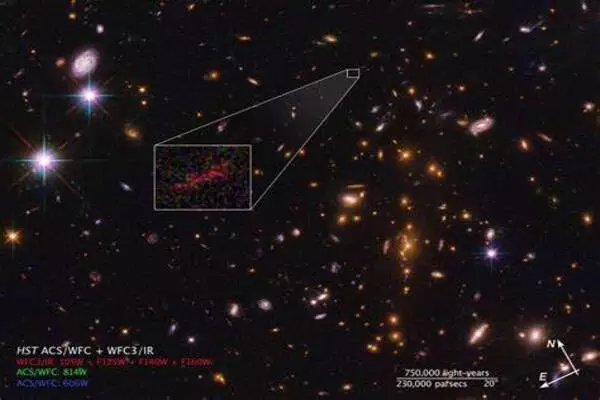Astronomers have found the magnetic field of a galaxy so far away that its light has taken more than 11 billion years to reach us: we view it as it was only 2.5 billion years ago. The discovery supplies scientists with crucial information regarding the formation of magnetic fields in galaxies such as our own Milky Way.
Astronomers have identified the magnetic field of a galaxy so far away that its light has taken more than 11 billion years to reach us: we see it as it was when the Universe was only 2.5 billion years old, using the Atacama Large Millimeter/submillimeter Array (ALMA). The result provides astronomers with vital clues about how the magnetic fields of galaxies like our own Milky Way came to be.
Many astronomical bodies in the Universe, whether planets, stars, or galaxies, have magnetic fields. “Many people may be unaware that our entire galaxy and other galaxies are laced with magnetic fields spanning tens of thousands of light-years,” says James Geach, an astronomy professor at the University of Hertfordshire in the United Kingdom and main author of the study published today in Nature.
Many people may be unaware that our entire galaxy and other galaxies are laced with magnetic fields spanning tens of thousands of light-years.
James Geach
“We actually know very little about how these fields form, despite their being quite fundamental to how galaxies evolve,” adds Enrique Lopez Rodriguez, a researcher at Stanford University, USA, who also participated in the study. It is not clear how early in the lifetime of the Universe, and how quickly, magnetic fields in galaxies form because so far astronomers have only mapped magnetic fields in galaxies close to us.
Geach and his colleagues have detected a completely developed magnetic field in a distant galaxy, comparable in structure to what is observed in neighboring galaxies, using ALMA, in which the European Southern Observatory (ESO) is a partner. The magnetic field is about 1000 times weaker than the Earth’s, but it spans over more than 16,000 light-years.
“This discovery gives us new clues as to how galactic-scale magnetic fields are formed,” Geach explains. Observing a completely established magnetic field so early in the Universe’s history suggests that magnetic fields covering entire galaxies can form quickly while newborn galaxies are still forming.

The researchers believe that vigorous star formation in the early Universe aided in the development of the fields. Furthermore, these fields can have an impact on how future generations of stars emerge. The discovery, according to co-author and ESO astronomer Rob Ivison, “opens up a new window into the inner workings of galaxies, because the magnetic fields are linked to the material that is forming new stars.”
To achieve this discovery, the researchers looked for light released by dust grains in a faraway galaxy called 9io9. Galaxies are densely packed with dust grains, and when a magnetic field is present, the grains tend to align, polarizing the light they emit. This means that rather than oscillating randomly, light waves oscillate in a particular direction. The presence of a magnetic field in a very distant galaxy was established for the first time when ALMA identified and mapped a polarised signal originating from 9io9.
“No other telescope could have achieved this,” Geach claims. The goal is that this and future measurements of distant magnetic fields will help to solve the enigma of how these fundamental galactic structures form.
















